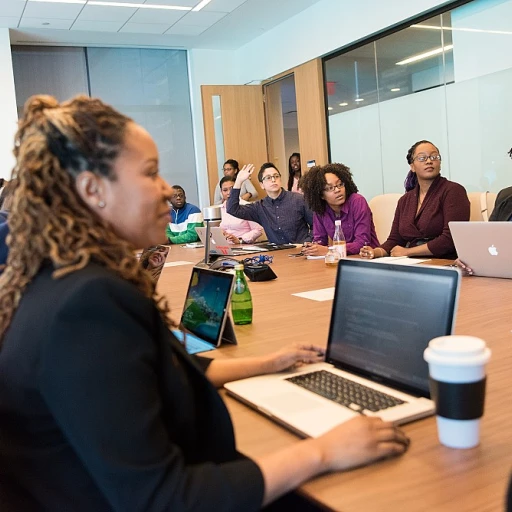
Understanding the Role of a Chief Human Resources Officer
Exploring the Multifaceted Role of a CHRO
The Chief Human Resources Officer (CHRO) plays a pivotal role in shaping the strategic direction of a company’s human resources function. As businesses evolve, so does the complexity of this role, which now extends beyond traditional HR responsibilities. The CHRO is expected to be a strategic partner, aligning HR strategies with the overall business model to drive organizational success.
In the realm of business model generation, the CHRO must possess a deep understanding of various business models and how they can be tailored to fit the unique needs of their organization. This involves leveraging tools such as the business model canvas, a concept popularized by Alexander Osterwalder and Yves Pigneur. The canvas helps in visualizing and designing innovative models that can address diverse customer segments and revenue streams.
The CHRO's role also involves being a catalyst for innovation within the HR function. This requires a keen understanding of market trends and the ability to adapt the company’s HR strategies to meet the changing demands of the market. By doing so, CHROs can create a competitive advantage for their organizations, ensuring that they remain agile and responsive to industry shifts.
Furthermore, CHROs are tasked with ensuring that the HR function contributes to the development of products and services that align with the company’s strategic objectives. This involves not only understanding the company’s product service offerings but also how these can be enhanced through effective HR practices.
For those aspiring to become CHROs, it is crucial to develop a broad skill set that includes strategic thinking, an understanding of business model patterns, and the ability to drive customer development. By mastering these skills, aspiring CHROs can position themselves as key players in the creation of game changers and visionaries within their organizations.
For more insights on how to maximize business impact through strategic HR leadership, you can explore this guide.
Key Skills Required for Successful Business Model Generation
Developing Core Competencies for Business Model Creation
In the ever-evolving landscape of human resource leadership, the pursuit of effective business models is crucial. At the core of this endeavor lies a set of key skills essential for successful business model generation. HR leaders must not only understand their company's model design but also possess the ability to innovate and adapt strategies to suit dynamic market circumstances. To craft viable business models that meet organizational needs, HR executives must hone the following competencies:- Strategic Visioning: A deep comprehension of the company’s vision allows HR leaders to align HR strategies with broader business goals, ensuring that HR initiatives actively contribute to the success of the organization.
- Customer Focus: Understanding customer segments is pivotal. Leaders must identify and cater to specific needs, leveraging customer development techniques to shape HR offerings, whether products or services.
- Innovation: Staying ahead in the competitive HR field demands innovative thinking. Developing new models or adapting existing ones to meet emerging market demands is a key facet of maintaining a competitive advantage.
- Analytical Skills: Numbers and data play a significant role in model generation. Utilizing data-driven insights aids in assessing the effectiveness of current models and helps in crafting data-informed strategies.
Innovative Business Model Strategies for HR Leaders
Building Innovative Strategies for the Modern HR Landscape
For HR leaders, the task of crafting business models that not only support but also enhance the organizational vision is increasingly becoming crucial. The development of innovative business model strategies requires a strategic mindset to navigate the current and future challenges within the HR landscape.
In HR leadership, the business model canvas becomes a critical tool. This strategic management template, devised by experts like Alexander Osterwalder and Yves Pigneur, provides a framework to map out key elements such as customer segments, value propositions, and revenue streams. By employing this tool, HR leaders can visualize and analyze their business models to ensure they align with organizational goals and adapt to market demands effectively.
- Customer-Centric Approach: The modern HR model must place a strong emphasis on customer development. Whether referring to internal customers (employees) or external clients (potential talent), understanding their needs and expectations is pivotal. By implementing customer feedback loops, HR leaders can refine their products and services to meet these demands, facilitating stronger engagement and satisfaction.
- Embracing Innovation: In the realm of HR, innovation is a game changer. As businesses evolve, HR leaders must also embrace digital transformation, leveraging technology to streamline processes and enhance employee experiences. From AI-driven talent acquisition systems to advanced employee engagement platforms, innovative solutions play a vital role in modern HR strategies.
- Multi-Channel Strategy: Incorporating a mix of channels to deliver HR services and products is vital. The use of digital platforms extends the reach and effectiveness of HR services, while traditional channels maintain the personal touch necessary for certain interactions. This multi-channel strategy supports a balanced and comprehensive service model.
Ultimately, the innovative strategies devised by HR leaders should be focused on long-term viability. Aligning with the overarching business objectives while promoting sustainability is crucial for achieving continued success. As markets evolve, so too must business models, adapting and responding to new trends and opportunities.
For HR professionals aiming to refine their strategic approach, understanding the nuances of navigating a career in change management can also provide valuable insights. Leveraging these innovative strategies positions HR leaders as visionary game changers within their organizations.
Challenges in Business Model Development for HR Executives
Common Hurdles Faced by HR Executives in Business Model Development
Developing an effective business model is a complex task for any executive, and HR leaders are no exception. One common challenge is aligning the business model with the company's overarching goals. Often, HR executives must navigate a landscape where the interests of various customer segments may not align perfectly with corporate objectives. This requires a delicate balance of vision and execution. Another challenge is innovation within the context of HR. The pressure to adapt to ever-changing market conditions can be intense. As the business environment evolves, HR leaders must constantly tweak their strategies, ensuring that models remain relevant and efficient. The capacity to innovate—using tools like the business model canvas—becomes crucial, pushing HR leaders to regularly evaluate and redesign their approach. The diversity of models available can also be overwhelming. The plethora of choices described in resources like the "business model generation handbook" can make decision-making difficult. Identifying relevant, game-changing strategies that stand out from others can be a daunting task. Additionally, creating a sustainable revenue stream within HR functions presents a unique set of obstacles. Adopting innovative revenue models while maintaining privacy policies and customer trust is critical, as it directly impacts the integrity of the HR department. Lastly, competition can be fierce, with many businesses vying to be recognized as visionaries and game changers in the HR field. Establishing a distinctive niche in the market often involves detailed market research and customer development analysis, drawing on works like "business model generation" by experts who have charted this path. Addressing these challenges requires a strategic approach involving constant learning and adaptation, staying informed of future trends, and employing best practices in model design. For further reading on how to enhance these skills in business model development, consider exploring resources on effective strategies for HR leadership.Case Studies: Successful Business Models in HR Leadership
Real-Life Applications: HR Business Models That Paved the Way
Creating effective business models within HR leadership is not just a theoretical exercise, it's a practical necessity. Successful application of such models can turn visionaries into change makers and elevate organizational strategy. Let's dive into some real-world applications that have set benchmarks in HR business model design.- Dynamic Customer Segmentation: One approach that has seen success is tailoring HR initiatives to various customer segments within the company. Understanding the different needs of employees, from entry-level to executive, enables HR to create targeted services and programs. Such segmentation allows for more personalized employee experiences, enhancing engagement and retention.
- Leveraging Alexander Osterwalder's Model Canvas: Many HR leaders have adopted the business model canvas approach from Alexander Osterwalder and Yves Pigneur. This framework facilitates a clear visual representation of key components like value propositions, customer relationships, and revenue streams. By leveraging these insights, HR leaders can design bespoke services that address specific organizational challenges.
- Innovative Revenue Streams in HR: Forward-thinking HR executives are generating additional revenue streams by designing tailored consulting services for other businesses. By leveraging their internal organizational expertise, they offer insights externally, creating a new product and service line.
Future Trends in Business Model Generation for HR
Embracing Future Possibilities for HR Leadership
In the rapidly evolving world of HR leadership, understanding future trends in business model generation is crucial for staying competitive and relevant. As HR continues to transform, embracing innovative strategies and adapting to new business needs becomes vital.- Technological Advancements: With the rise of AI and automation, HR leaders must rethink how they can integrate these technologies into their models. Leveraging AI for tasks such as talent acquisition and performance management can streamline processes, creating more time for strategic activities.
- Focus on Employee Experience: Future business models are likely to prioritize employee experience as a key component of success. Understanding customer segments, HR leaders need to tailor their approaches to meet the diverse needs of their workforce, consequently impacting engagement, retention, and productivity.
- Sustainability and Social Responsibility: As businesses become more environmentally conscious, HR models must adapt by integrating sustainable practices within all operations. This includes designing products services that not only enhance business outcomes but also contribute positively to society and the environment.
- Flexible Work Models: The shift towards remote and hybrid work arrangements calls for a reevaluation of the traditional business model canvas. HR leaders will need to incorporate flexibility into their business models, ensuring that they can accommodate various work preferences and structures.
- Data-Driven Decision Making: Harnessing big data and analytics will be a linchpin for future HR strategies. By utilizing data more effectively, HR leaders can create precise models that drive organizational goals and facilitate the development of innovative model patterns.
- Dynamic Market Adaptation: Navigating the ever-changing market landscape calls for adaptability. Successful HR leaders will cultivate business models that are agile, allowing for quick pivots in strategy to seize emerging market opportunities.












